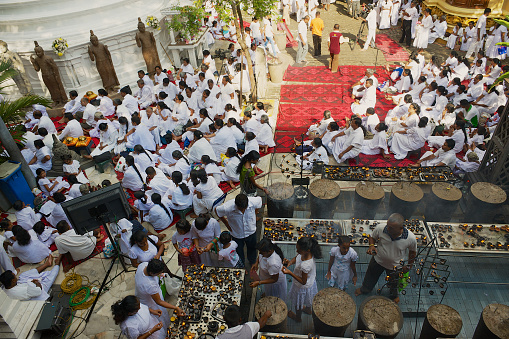Following the encounter with Buddhism in Sri Lanka, different faiths and beliefs that existed in the society in real-time started to be more systematic. It shows how Buddhism on a larger scale innovated people. Thereafter, people were distanced from the constitutional mentality and drawn to advanced thinking. Parallel to that, everyone positive development in spiritual, cultural, political, and social aspects were witnessed. It is doubtful if we are currently distancing from that positive mindset and dragging back to a pre-Mahinda era.
A Buddha appears in the world ensuing a long period, to aid all living beings to overcome the Saṃsāra. This fact is very well depicted by the story about the hermit Sumedha who gave up attaining ‘Nibbāna’ at the feet of the ‘Dipankara’ Buddha for the sake of future Buddhahood. He made the sacrifice with the aim of helping every sentient being to overcome the suffering of ‘Samsāra’. The Buddha clearly taught how to overcome the suffering and showed the exact pathway. To end the Saṃsāra, one has to figure out what and how we should cut off certain things from our lives. Out of what the Buddha taught was ‘paticcasamuppada’ which explains the causality, the suffering generated out of it and how to defeat the cause root causes for suffering are unique teachings. Simultaneously he taught ‘Four Noble Truths’ and ‘Eight Noble Paths’ as well.
The aforementioned facts bring out the final results of a practical process. Accordingly, Buddhism is not subtle or basic; Buddhism is strictly practical and pragmatic.
Buddha once preached: ‘desetha bhikkave dhammaṅ adi kalyānaṅ, majje kalyānaṅ, pariyogana kalyānaṅ’ which means,
“In this Dhamma, the beginning is good, the middle is good and the end is good; this Dhamma is everlasting. It is common in every period. Anyone can question this Dhamma and make their doubts clear”
On every occasion, Buddha wanted this Dhamma to be practical in every aspect. In spite of the fact, a doubtful situation has been created in the modern society about the practical usage of this Dhamma.
It has been a long time since the ‘Pirinibbāna’ of the Buddha. The level of intelligence of the social animal too has been increased. Every unit in society has evolved since then; in fact, it still is evolving. Buddhism has also been subjected to change with these evolutions. Many things have also been added.
Our Buddha never expected any offerings or rituals full of floral perfumes and various decorations from his followers. It is a quality of a noble person. However, in the ‘Ananda Bodhi Ropanaya,’ it is mentioned that the above-mentioned offerings are suitable when recompensing faith towards the Buddha.
When offering the Buddha ‘Amisa puja’ and ‘prathipaththi puja’ are prominent. Even though all these pujas are performed to offer the Buddha, people should be more inclined to carry out ‘Prathipaththi puja’. However, in the present time, people tend to perform ‘Amisa puja’ to a greater extent. Mustard oil offerings, Jasmine flower offerings, relic revering, lighting oil lamps, and sermons are performed as ‘Amisa puja’ by the society. When these numeric symbols that claim to be Buddhism increase, corresponding to that, the main core of Buddhism fades away. I am not saying that the aforementioned ‘Āmisa Pujas’ are false; they are just not what the Buddha expected from living beings. Those things only provide us a mental satisfaction. All those pujas later evolved around Buddhism, none of them were initially there in the Buddhist Philosophy or teachings; they are all outside the concept of ‘Nibbāna’. Constructing Buddha statues in every junction, constructing sky-high stupas, initiating quantities of societies, or doing ‘pujas’ does not matter if one forgets to precede the policies of Buddhism; one can not attain the concept of ‘Nibbāna’ initiated by the Buddha by just putting on the label of Buddhism. When looking at all the ‘Amisa Puja’ performed by the Sri Lankans it is arguable if, we have back to the period before ‘Arahat Mahinda’.
Buddha Preached to all living beings,
‘yo dhammaṅ passata; so maṅ passati’
The Buddha said ‘If you see the ‘Dhamma’, you see me’.
Therefore, if we want to see the Dhamma, shouldn’t we practically include it in our lives? It’s like being able to understand the Buddha’s attempts by studying and practicing Buddhism. A new understanding can be made in Sri Lankan Buddhism by including more practical things in it rather than symbolic things.
Buddha has mentioned a beautiful metaphor,
There are 3 objects that become powerful when they shine, the sun, the moon, and the Dhamma.
The more the sun shines the more powerful it gets. The more the moon goes away from the clouds the more it shines, just like that the Dhamma shines more when it outstretches to all living beings.
The main goal of the Buddha’s renunciation was ‘kiṅ sacca gavesi’; ‘To find what is the truth? What is the truth that we should search for?’. Therefore, the more you try to find Buddhism through ‘Amisa puja’ the more Buddhism becomes symbolic. If one is stimulated to search and study Buddhism, that person will be able to understand the Buddha’s Dhamma swiftly without a doubt.
© Satipatthana Magazine

